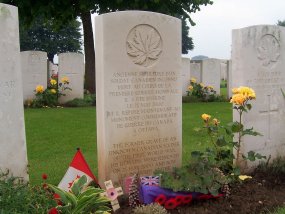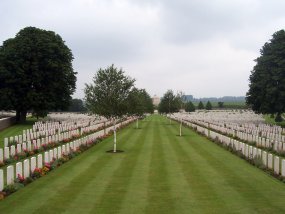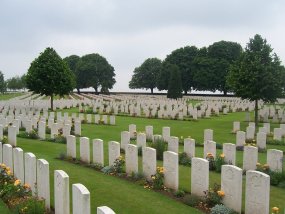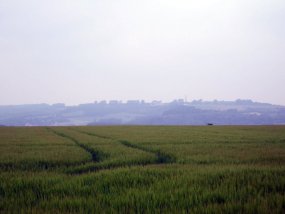
WWII: Maginot Line | Normandy | V-Weapon Sites | Arnhem
Further afield: Crete
| Home Tracing Military Ancestors Travel Advice CWGC Cemeteries Iron Harvest News Book Reviews Glossary Links Contact Me Artois:
 
|
Location 4 – Cabaret Rouge CWGC Cemetery
Directions – Continue on the main D937 towards Arras. Within a few minutes you will reach a CWGC Cemetery on the right. Park the car by the information boards by the entrance.
Historical Notes – Located on the site of a café - the "Cabaret Rouge" - which was destroyed in the 1915 fighting, this is the largest CWGC Cemetery in Artois with over 7,000 burials. Formerly here and now marked with a special memorial was the Canadian Unknown Soldier now interred at the Canadian National War Memorial in Ottawa. The cemetery was started by the British in 1916 and continued up to 1918 before being further expanded as a concentration cemetery post war. As you look out to the west from the rear of the cemetery you are looking out over the open ground won at such cost by the French during 1915. Eyewitness Account – Captain Humbert, in his superb account of the 1915 fighting, paints a vivid and terrible picture of the scene here in May of that year: "Temporarily seized with panic, the Germans quickly recovered. All their available reserves and artillery from the Artois, Picardy and Flanders fronts, were concentrated near Lens, in an effort to throw the French back on their departure bases. The bombardment accurately regulated from the tope of Hill 119, increased hour upon hour. The trees along the Béthune road were gradually cut to pieces by the shells, and the Cabaret Rouge fell down. The survivors of the French attack, who had no time to dig themselves in deeply, lay on the ground, behind slight ridges of earth, which afforded little protection against the splinters. The number of the wounded increased with disconcerting rapidity, but they were forced to stay where they were, among the Tirailleurs, as the barrage prevented any movement being made to the rear. The field kitchens could not reach the men whose water-bottles were empty. The heat was suffocating on the arid plateau, and the men, mad with thirst, drank their own water." Accreditations – Extract taken from Illustrated Michelin Guides to the Battle-Fields (1914-1918) Arras Lens – Douai and the Battles of Artois by Michelin & CIE, G H Smith & Son, Easingwold, York 1994.
|
||||||||




